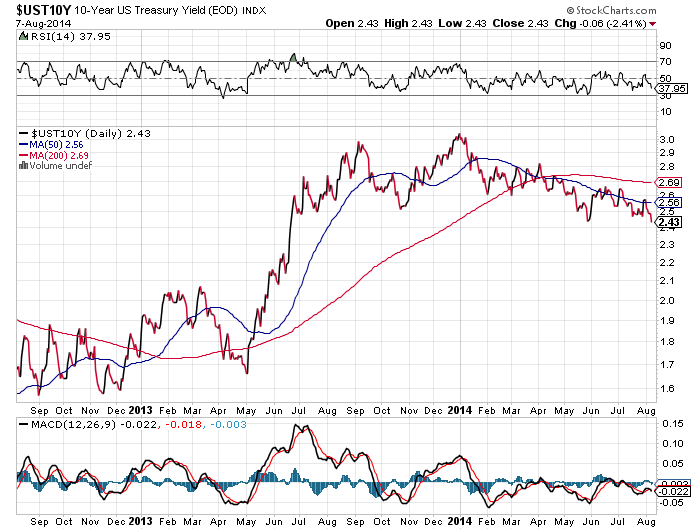Treasury yields fell again yesterday, with the benchmark 10-year rate slipping to 2.43% at Thursday’s close—marking a 13-month low. More of the same is on tap at the moment: Early trading on Friday shows the yield dipping below 2.40%. Lower yields at this stage are a warning sign, of course, albeit inspired by a hodgepodge of factors. The good news is that macro weakness in the US isn’t a catalyst at this point, as suggested by yesterday’s drop in weekly jobless claims, which left the four-week-average for this leading indicator at an eight-year low. The unexpected decline in claims points to the possibility that growth in the US labor market is picking up. But the improving macro news comes at a time when risk-off sentiment is on the rise.
The problem is that geopolitical threats, along with new concerns about the macro trend in Europe, are on the march. The sources of the heightened uncertainty about what happens next include the lingering Ukraine crisis, the explosive situation with Israel’s invasion of Gaza, and the return of US military action in Iraq, albeit partly for humanitarian reasons at the moment. It’s fair to say that there’s a swirling set of issues that are driving the 10-year yield lower. The one bright spot: worries about the US economy aren’t fueling the safe-haven trade.

One sign that fears about the US economy aren’t a big issue: the market’s inflation forecast (based on yield spread between the nominal 10-year Treasury less its inflation-indexed counterpart) has remained stable in the low-2% range lately, or roughly in line with the Fed’s target. Disinflation/deflation risk, in short, still looks contained, in no small part because moderate growth persists. Good thing, too, since a new round of macro trouble for the world’s biggest economy would add a substantially heavier load to the already darkening mood.
But this is a fluid situation. The potential for negative macro repercussions around the world can’t be dismissed, and markets are reacting accordingly. It may turn out to be an over-reaction, but liquidity demand is on the rise for now. “There’s a flight to quality,” an interest-rate strategist in Tokyo at BNP Paribas tells Bloomberg. “Tension is rising globally. Since the start of the month, equity markets are off sharply and bonds are rallying. That should continue.”
Wayne Bowers at Northern Trust agrees. “There’s been a continued escalation both in the Middle East and in the Ukraine and Russia,” he says via The Wall Street Journal today. “Up until recently markets had been able to ignore these geopolitical tensions. But none of these situations seems to be on a path towards resolution—they seem to be bubbling up or getting worse.”
The rush to safety is evident in Europe as well, where the Germany 10-year bond has been trading at a new record low, at slightly above 1.0%. Not an encouraging trend. As Breakingviews notes:
The German government looks poised to join a club it may not want to enter. Like Japan and Switzerland, the German state is on the verge of being able to borrow money for 10 years for less than 1 percent. Unfortunately, membership of this select circle tends to come with high economic costs.
The yield on 10-year German paper has halved in less than a year to hit a record low of 1.02 percent on Aug. 8. The decline helps other euro zone countries reduce their debt servicing costs, since German debt is a regional anchor. However, the necessary (though not sufficient) conditions which seem a prerequisite for entry into this very exclusive “sub-1 percent” club are far from welcome.
The critical issue now is monitoring geopolitical risk for signs that the blowback is taking a toll on the economic data. That’s a given for Europe, which is relatively dependent on Russian energy and so Germany, France and the rest of the Continent may pay a price if tensions persist. The increasingly unstable situation in Iraq throws another joker into the deck. Now that President Obama has authorized US airstrikes against militants in Iraq, a new, more toxic phase of Middle East risk factors seems to be in play.
It’s no trivial point that the US economy seems to be holding up quite well. But make no mistake: a run of bad macro data at this stage would be dark news. That doesn’t seem likely, based on the current figures. But negative surprises in the days ahead won’t be easily dismissed.
The optimistic scenario is that crowd’s worries ease and the risk-off trend reverses course. It’s all about perceptions, and the hard data for the US. “Risk aversion reigns, risk aversion rules,” reminds the head of currency strategy at Societe Generale in London.
